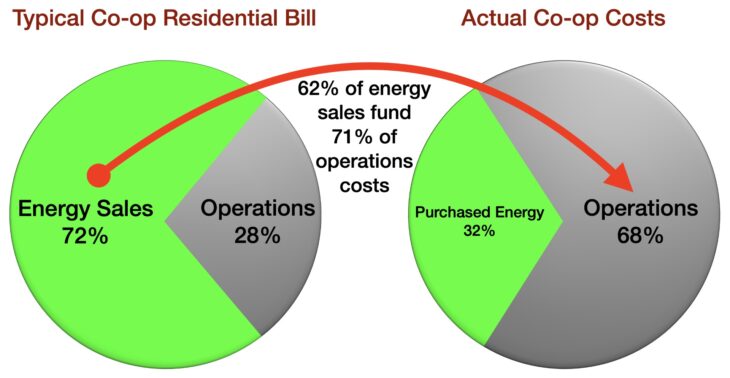Quick Fact: Essential Public Facilities
ESSENTIAL PUBLIC FACILITIES is a legal category for hard to site public serving facilities that local codes can outline mitigation conditions but without outright prohibition. Essential Public Facility status ensures that essential services are planned for and accessible.
To meet the energy load increases that the San Juan Comprehensive Plan (30-50%) is calling for – OPALCO will need to have some local renewable generation, add a third very expensive submarine cable from the mainland, or live with unreliable power.
Challenges:
- Current land use policies limit local renewable energy development.
- Regional energy shortages and submarine cable capacity limits.
- No new hydropower and reduced snowpack.
- Less than 5% of energy needs can be met by rooftops alone.
- OPALCO is committed to providing reliable, uninterrupted service.
If San Juan County is willing to allow for permits on development that will lead to the predicted load growth, then OPALCO needs to be able to meet that demand in a strategic, cost-effective manner. By categorizing renewable energy microgrids as EPFs then OPALCO can better plan to meet future load with carbon free resources that will benefit the whole of the cooperative. OPALCO needs permitting predictability for renewable energy projects to be able to plan for, site, and leverage grants funds when available.
OPALCO is asking to:
- Recognize Local Renewable Energy Projects as Essential Public Facilities
Energy infrastructure is as critical as water, communications, and emergency services. The Comprehensive Plan should formally recognize utility-scale solar and microgrid facilities as essential public facilities (EPFs)—giving them the same planning priority and permitting pathways as other crucial services needed to support our island community and local energy independence.
Essential Public Facilities does not bypass permitting requirements, environmental standards, and community outreach, including but not limited to:
- Critical Areas: Protection of wetlands, wildlife habitats, and other sensitive areas.
- Stormwater Management: Compliance with county stormwater requirements.
- Utility Fencing Standards: Meeting safety and security fencing requirements.
- Clearing and Grading: Following county codes and best practices.
- Cultural and Archaeological Protections: Ensuring sites do not impact significant cultural or archaeological resources.
- Mitigation Requirements: Follow mitigations needed on any given site.
- Other Environmental Impacts as defined in State Environmental Protection Act (SEPA): Ensure that air quality, floodplain regulations, light/glare, discharge of waste, runoff, invasive species, Comp Plan alignment, and preservation requirements can be met.
- Land Use Designations: Only parcels with land use designations allowable under San Juan County planning regulations should be considered
- Cost considerations: Land, site preparation, and equipment are increasingly expensive – every site would need to be evaluated to ensure that the cost profile makes sense and likely the co-op will need to leverage grant funds.
What can utility scale battery and solar projects do:
- Cost-effective and reliable energy, especially in winter.
- Agrisolar projects can enhance farming, soil health, and food production.
- Offer another level of energy resilience.
- Prevents carbon-based resources from being added on the mainland.
Check out all suggestions OPALCO is making for the Comp Plan: https://www.opalco.com/quick-fact-san-juan-county-comprehensive-plan/2025/04/
Here is the San Juan County Code that governs this process – 18.30.055
18.30.055 Siting and permitting of essential public facilities (EPFs).
The Growth Management Act directs that no comprehensive plan or development regulation may preclude the siting of essential public facilities (RCW 36.70A.200(2)). The identification, location, and permitting of essential public facilities shall be guided by the policies of the Comprehensive Plan, including Section B, Element 2 (Land Use), Element 3 (Shoreline Master Program), and Appendix 2 (Joint Planning Policies), along with the requirements of SJCC Titles 16 and 18.
A. Proposed facilities that satisfy County development standards shall follow the standard permitting procedures. Facilities that do not meet one or more development standards may be permitted as provided in this section.
B. Determination of an Essential Public Facility. Essential public facilities are identified in both the Comprehensive Plan and the definition section of this title. Additional essential public facilities may be identified by either amendment to the Comprehensive Plan and this chapter or by submission of a request for EPF determination as follows:
1. A request for determination that a facility is an EPF shall contain a conceptual description of the facility, an explanation of the need for the facility, a preliminary development schedule, identification of any sites that are under consideration, and required fees.
2. After receiving such a request, the County council shall hold a public hearing to discuss the request. At least 45 days prior to the meeting, the department shall provide notice in the legal section of the official County newspaper, and if particular sites are under consideration, at least 45 days prior to the meeting, notice shall be mailed to all owners of property within 500 feet of the parcel boundaries of those sites.
3. Following the public hearing, the County council shall adopt a resolution as to whether the proposed facility is an EPF.
C. Siting of New EPFs. The following procedures provide a method for siting essential public facilities when there is no suitable site with a land use designation that allows the proposed use:
1. Prior to initiating the following process the applicant shall pay the associated fees.
2. The department and applicant shall identify potential sites for the proposed facility.
3. The applicant shall analyze potential sites based on consideration of the following criteria along with any factors identified by the department which are specific to the proposed type of facility:
a. Potential impacts on existing land uses, resource lands, open space, scenic resources, critical areas, and the natural and rural environment;
b. The priority for the protection of resource lands;
c. How the location will help maintain or enhance the quality or minimize the cost of the service;
d. Economic, social and environmental impacts and benefits to the public;
e. The siting criteria and recommendations provided by the joint County/town of Friday Harbor task force, if it is established (applicable only to facilities located on San Juan Island);
f. Prevention of incompatible uses adjacent to general aviation airports;
g. The extent to which design features or operational conditions can eliminate or reduce unwanted project impacts; and
h. Whether the site is capable of being redesignated to an appropriate land use designation, i.e., whether it is capable of meeting the Comprehensive Plan goals and policies for a designation that allows the proposed essential public facility.
4. The applicant shall prepare an analysis and comparison of the potential site using the criteria described above.
5. The department and applicant shall hold a public meeting to discuss the analysis and the potential sites. At least 45 days prior to the meeting, the department shall provide notice in the legal section of the official County newspaper, and at least 45 days prior to the meeting, notice shall be mailed to all owners of property within 500 feet of the parcel boundaries of the sites under consideration.
6. Following this meeting the applicant shall select the site and prepare a written request to the County council for approval of the site and authorization to apply for redesignation of the site. This request shall include a conceptual description of the facility, a conceptual site plan, an explanation of the need for the facility, an explanation of the methodology used to select the site, the analysis and comparison of sites that were considered, and an explanation of why the proposed site was selected.
7. After receiving such a request, the County council shall conduct a public hearing to accept public input. At least 45 days prior to the hearing, the County shall provide notice in the legal section of the newspaper of record, and at least 45 days prior to the hearing notice shall be mailed to all owners of property within 1,000 feet of the parcel boundaries of the proposed site.
8. If the council finds that the proposal is appropriate and in the public interest based on the above selection criteria, analysis and testimony, it shall approve the site and authorize application for redesignation.
If the request is denied, the council shall state the reasons for denial, shall identify preferred alternative sites, and shall identify actions the applicant can take to gain approval of a site.



